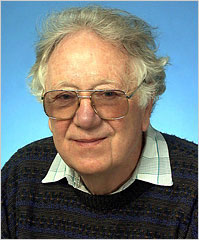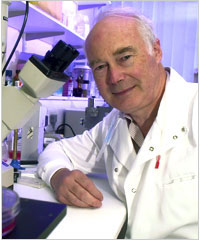2007 Nobel Medicine honors stem cell research
Yesterday (October 8), the 2007 Nobel season officially opened with the announcement of the Nobel Prize for Medicine belonging to three British, American and Italian researchers. This is the first of six prestigious awards to be announced by Nobel committees from now until October 15.
Three scientists Mario R. Capecchi (Italy), Martin J. Evans (England) and Oliver Smithies (USA) have made a breakthrough series of discoveries about embryonic stem cells and DNA. Their studies paved the way for a powerful technology to manipulate genes in mice - targeting genes in mice.
This powerful technology is currently being applied to almost all areas of biomedical research, from basic research to the development of new therapies.
Targeting genes is often used to neutralize single genes. Such "demineralization" experiments shed light on the role of countless genes in infancy, aging, disease and adult physiology. So far, more than 10,000 mouse genes (about 50% of the genes in this animal) have been disabled. The international scientific community will continue to disable the remaining genes in the near future.
With gene technology, scientists can now transform DNA in the mouse genome, helping them determine the role of single genes involved in disease and health. Targeting genes has produced more than 500 different human disorders in mice, including cardiovascular disease, neurological depression, diabetes and cancer.



From left: Oliver Smithies , Martin J. Evans and Mario R. Capecchi (Photo: Nytimes.com)
The gene-targeting technology has helped people understand the role of hundreds of genes during the development of mammalian fetuses. Capecchis' research has discovered the role of genes involved in organ development and body structure. He clarified the causes of many forms of birth defects in humans.
Evans applied this technology to develop human disease patterns in mice, including hereditary pancreatic fibrosis. He used these models to study disease mechanisms and test the effects of gene therapy.
Smithies also uses gene-targeting technology to develop models of human genetic diseases in mice, such as pancreatic cystic fibrosis and marine anemia. He also developed countless common human disease patterns in mice such as atherosclerosis and hypertension.
In short, the gene-targeting technology in mice has invaded all areas of biomedical. Its impact on understanding the function of genes and its benefits to humankind will continue to increase over the years to come.
This year's Medical Prize is worth $ 1.54 million. Last year, the Nobel Prize for Medicine belonged to two American scientists - Andrew Z. Fire and Craig C. Mello, who discovered the mechanism of RNA interference - a process that could silence certain genes.
Dr. Mario R. Capecchi was born in 1937 in Italy and is a US citizen.He graduated with a doctorate in biological physics from Harvard University in 1967. He is currently an Emeritus Professor of Human Genetics and Biology at the University of Utah, USA.
Dr.Martin J. Evans, born in 1941 in England, and is currently a British citizen.He holds a doctorate in anatomy and embryology in 1969 in England.He is currently the Principal of the School of Biology and Professor of Mammal Genetics, Cardiff University, England.
Dr. Oliver Smithies, born in 1921 in the United States, graduated with a doctorate in chemistry in 1951 at Oxford University, England.He is currently Professor of Excellence in Pathology, University of North Carolina, USA.
Minh Son (synthesized)
- The Nobel laureate of stem cells will cooperate with China
- The 2016 Nobel Prize for Medicine honors the study of cell self-destruction
- Chinese scientist sues the Nobel Council
- Japanese scientist and stem cell story
- Be careful about stem cell therapy
- LEARN ABOUT ORIGINAL CELL (Last part)
- Things to know about the Nobel Prize for Medicine
- More details about the 2015 Nobel Prize for Medicine: When the East and West Medicine combined
- Self-cell cells in the Nobel Prize for Medicine help treat critical diseases
- The US dropped the ban on funding for stem cell research
- What are stem cells? How advanced is medicine in this area?
- Mexico focuses on promoting the creation of stem cell banks
 Vietnam 5th Asian champion on fuel-efficient vehicles
Vietnam 5th Asian champion on fuel-efficient vehicles We can read all NASA studies completely free of charge
We can read all NASA studies completely free of charge Singer and songwriter Bob Dylan won the 2016 Nobel Prize for Literature
Singer and songwriter Bob Dylan won the 2016 Nobel Prize for Literature Scientific revolution in Asia
Scientific revolution in Asia